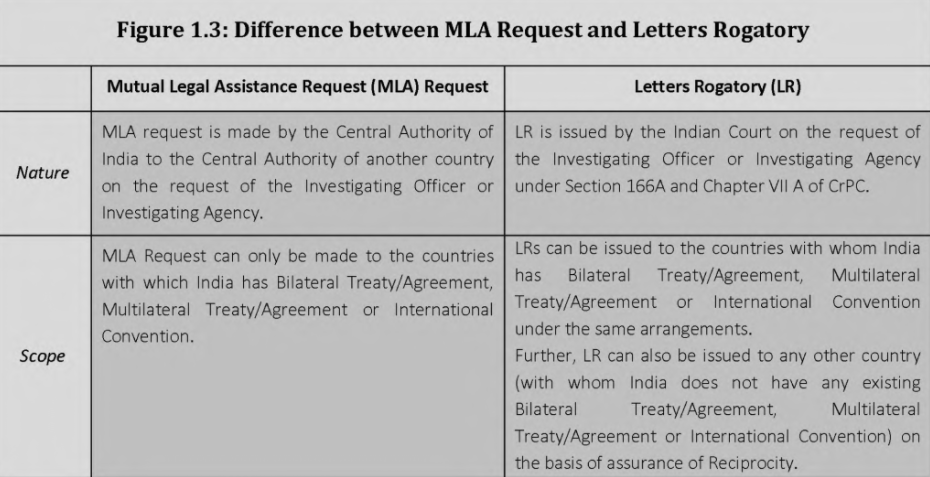The Process Involved in Declaring Letters Rogatory: A Step-by-Step Guide
The Process Involved in Declaring Letters Rogatory: A Step-by-Step Guide
Blog Article
The Duty of Letters Rogatory in International Regulation: Secret Insights
Letters rogatory work as an essential instrument in international regulation, assisting in cross-border legal support by allowing territories to officially request proof and actions from each other. Rooted in historic precedents and formalized through arrangements like the 1970 Hague Convention, these demands are essential for fostering international cooperation. Their implementation usually encounters considerable obstacles, consisting of inconsistencies in lawful standards and step-by-step delays, which can prevent their efficacy. Understanding the subtleties of this procedure raises crucial concerns about worldwide cooperation and the potential reforms required to improve its dependability. What ramifications might these challenges have for future legal procedures?
Interpretation of Letters Rogatory
In the realm of worldwide regulation, letters rogatory act as formal demands released by a court in one territory to seek aid from a court in one more territory. Letters rogatory. These demands are particularly significant in cross-border legal process, where the enforcement of a court's order or the celebration of evidence might be impeded because of jurisdictional constraints

The process normally requires the requesting court to express the details information or activity needed from the international court, adhering to the lawful procedures and conventions established in between the jurisdictions involved. Once issued, the letters rogatory are transferred via diplomatic networks, which may include consulates or embassies, to guarantee that the request is acknowledged and acted upon by the international court. Generally, letters rogatory exhibit the participating structure important for reliable worldwide lawful procedures.
Historical Context
Although the method of letters rogatory has ancient roots, its formalization within the framework of worldwide legislation emerged considerably in the 20th century. Historically, such requests for judicial assistance were used in different legal customs, including Roman regulation, where they assisted in cross-border collaboration in legal matters. The idea gained renewed attention with the increase of globalization and the raising complexity of worldwide legal interactions.
The mid-20th century saw the establishment of treaties and conventions that sought to standardize the procedure of letters rogatory. Significantly, the 1970 Hague Convention on the Taking of Evidence Abroad in Commercial or civil Matters supplied a structured strategy, enhancing the efficacy of these requests - Letters rogatory. This period marked a change from casual plans to an extra methodical framework, which dealt with the difficulties postured by varying nationwide legal systems
As states came to be a lot more interdependent, the need for reliable systems to gather proof across borders emerged, enhancing the role of letters rogatory in helping with international teamwork. Today, they stay a crucial instrument for obtaining proof and guaranteeing that justice transcends national boundaries, showing the progressing nature of global regulation in reaction to global difficulties.
Refine of Issuing Demands
The procedure of issuing letters rogatory typically involves numerous critical steps designed to ensure that requests for judicial assistance are clear, specific, and certified with both domestic and worldwide lawful criteria. Initially, a party looking for assistance has to prepare a formal demand that describes the essential truths of the instance, the relief looked for, and the certain proof or testament needed. This file must be crafted with precision to meet the legal demands of the jurisdiction in which it will be sent.
Complying with the prep work of the demand, it is sent to the ideal authority, typically a court or a designated governmental company. This authority reviews the request to ensure it sticks to lawful requirements and step-by-step standards. When approved, the request is transmitted to the foreign jurisdiction via polite networks.
Upon receipt, the foreign court assesses the demand's compliance with its regional laws and techniques (Letters rogatory). If approved, it proceeds to implement the demand, which may entail the issuance of subpoenas or the collection of evidence. Throughout this process, keeping clear communication between the asking for and obtaining territories is essential to make certain effective cooperation and the satisfaction of the request
Challenges and Limitations
Difficulties and limitations regularly develop in the process of carrying out letters rogatory, often stemming from differing lawful systems and treatments between jurisdictions. One significant obstacle is the varying criteria of admissibility for evidence, which can lead to problems in the approval of documents requested via letters rogatory. Additionally, click for info the absence of uniformity in legal terminology and definitions can develop misconceptions, making complex interaction between courts useful content in different countries.
Moreover, hold-ups prevail as a result of bureaucratic procedures, as the request may need to travel through numerous layers of legal authorities before it is met. In some instances, the asked for territory may do not have the needed resources or willingness to coordinate, even more impeding the process. Language barriers additionally add to difficulties, as exact translation of legal files is crucial for making sure that the desired message is conveyed without distortion.
Lastly, sovereignty problems may arise, as some states hesitate to follow requests that they regard as infringing upon their lawful freedom. These obstacles highlight the intricacies fundamental in using letters rogatory, demanding greater harmonization and participation amongst worldwide legal systems to enhance their effectiveness.

Influence on International Collaboration
Acknowledging the importance of letters rogatory in cultivating global participation is vital, as these demands promote cross-border lawful help and advertise collaborative initiatives in criminal and civil matters. By enabling one territory to officially ask for help from an additional, letters rogatory create an organized legal structure that enhances the effectiveness of worldwide communication in between judicial authorities.
Making use of letters rogatory helps to develop common count on and respect amongst nations, which is important in an increasingly interconnected world. They offer as a mechanism not only for collecting proof but additionally for ensuring that lawful processes are upheld throughout boundaries. This is particularly essential in combating multinational crime, where the failure to safeguard collaboration can undermine justice.
Moreover, the reliance on letters rogatory can improve intricate lawful process, minimizing hold-ups and unpredictabilities in international investigations. The step-by-step safeguards inherent in this procedure contribute to the security of private legal rights while assisting in cooperation among states. Ultimately, the impact of letters rogatory on international cooperation highlights their role as visit our website crucial tools in the promo of justice, cultivating a joint spirit that goes beyond legal systems and national boundaries.
Verdict
In conclusion, letters rogatory act as an important tool in worldwide law, facilitating cross-border legal support and participation. In spite of intrinsic difficulties such as varying legal requirements and governmental hold-ups, their standard procedures advertise depend on among nations. The ongoing development of these devices is essential for enhancing the effectiveness of international legal procedures, eventually fostering more powerful cooperation in both civil and criminal matters across territories. The value of clear communication in this context can not be overemphasized.
Letters rogatory serve as an essential instrument in global regulation, assisting in cross-border legal help by permitting jurisdictions to formally ask for proof and actions from one an additional.The process typically needs the requesting court to verbalize the specific information or action required from the international court, sticking to the lawful procedures and conventions developed between the jurisdictions included. Historically, such requests for judicial support were used in different lawful traditions, including Roman legislation, where they assisted in cross-border cooperation in lawful issues.The procedure of issuing letters rogatory typically includes several critical actions designed to guarantee that requests for judicial help are clear, details, and certified with both residential and global lawful standards.Moreover, delays are usual due to governmental procedures, as the request may require to pass via multiple layers of lawful authorities prior to it is met.
Report this page